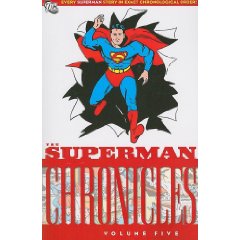
By Jerry Siegel & Joe Shuster, Wayne Boring, Jack Burnley and the Superman Studio (DC Comics)
ISBN: 978-1-84576-895-9
By the time these tales first saw print Superman was a bona fide phenomenon, and had utterly changed the shape of the fledgling comicbook industry. There was a popular newspaper strip, foreign and overseas syndication and the Fleischer studio was starting production on some of the most expensive -and best – animated cartoons ever produced. Thankfully the quality of the source material was increasing with every four-colour release, and the energy and enthusiasm of Siegel and Shuster had transferred to the burgeoning studio that grew around them to cope with the relentless demand.
This fifth collection of the Man of Steel’s earliest adventures, reprinted in the order they originally appeared, takes us from the beginning of the year to May of 1941; another astounding voyage of thrills and chills that covers his appearances in Action Comics #32-36, the bi-monthly Superman #8-9 as well as his first landmark appearance in the legendary publication World’s Best Comics #1.
As ever, each tale is preceded by the original cover illustration, and the unsung talents of Paul Cassidy and especially Fred Ray should be appreciated for the huge part they played in capturing the attentions of the millions of kids who were daily bombarded by a growing multitude of garish, gaudy mystery-men
We lead off with Action Comics #32 (cover-dated January 1941), ‘The Gambling Racket of Metropolis’ (although like many stories of the time there was no original title and it’s been designated as such simply to make my job a little easier…) wherein the Action Ace crushes an illicit High Society gambling operation that has wormed its nefarious way into the loftiest echelons of Government, a typical Jerry Siegel social drama magnificently illustrated by the great Jack Burnley
Superman #8 (Jan/Feb 1941) was another spectacular and varied compendium containing four big adventures ranging from the fantastic fantasy ‘The Giants of Professor Zee’ (illustrated by Paul Cassidy), topical suspense in ‘The Fifth Column’ (Wayne Boring & Don Komisarow), common criminality in ‘The Carnival Crooks’ (Cassidy again) and concluding with an increasingly rare comic-book outing for Joe Shuster – inked by Boring – in the cover-featured ‘Perrone and the Drug Gang’, as the Metropolis Marvel battled doped-up thugs and the corrupt lawyers who controlled them.
Action Comics #33 and 34 are both Burnley extravaganzas wherein Superman goes north to discover ‘Something Amiss at the Lumber Camp’, before heading to coal country to save ‘The Beautiful Young Heiress’; both superbly enticing character-plays with plenty of scope for eye-popping super-stunts to thrill the gasping fans.
Superman #9 (March/April 1941) was another four-star thriller with all the art credited to Cassidy and the Shuster Studio. ‘The Phony Pacifists’ is an espionage thriller that capitalised on increasing US tensions over “the European War”, ‘Joe Gatson, Racketeer’ recounts the sorry end of a hot-shot blackmailer and kidnapper, ‘Mystery in Swasey Swamp’ combines eerie happenings with ruthless spies and the self-explanatory ‘Jackson’s Murder Ring’ pits Superman against an ingenious gang of commercial assassins.
The success of the annual World’s Fair premium comic-books had convinced the editors that an over-sized anthology of their characters, with Superman and Batman prominently featured, would be a worthwhile proposition even at the exorbitant price of 15¢ (most 64 page titles retailed for 10¢ and would do so until the 1960s). The 96 page World’s Best Comics #1 (and only) debuted with a Spring cover-date, before transforming into the venerable World’s Finest from issue #2 onwards. From that landmark edition comes a gripping disaster thriller ‘Superman vs. the Rainmaker’ illustrated by Cassidy, whilst Action Comics #35 headlined a human interest tale with startling repercussions in ‘The Guybart Gold Mine’, and this volume concludes with Superman mightily stretched to cope with the awesome threat of ‘The Enemy Invasion’, a canny taste of things to come if America entered Word War II.
Stories of corruption, disaster and social injustice were typical of the times, but with war in the news and clearly on the horizon, the content of Superman adventures was changing: and so, necessarily, did the scale and scope of the action. The raw intensity and sly wit still shone through in Siegel’s stories which literally defined what being a Super-hero meant, but as the world became more dangerous the Man of Tomorrow simply became stronger and more flamboyant to deal with it all, and Shuster and his team stretched and expanded the iconography that all others would follow.
These Golden Age tales are priceless enjoyment at an absurdly affordable price. What more so you need to know?
© 1940, 2008 DC Comics. All Rights Reserved.
